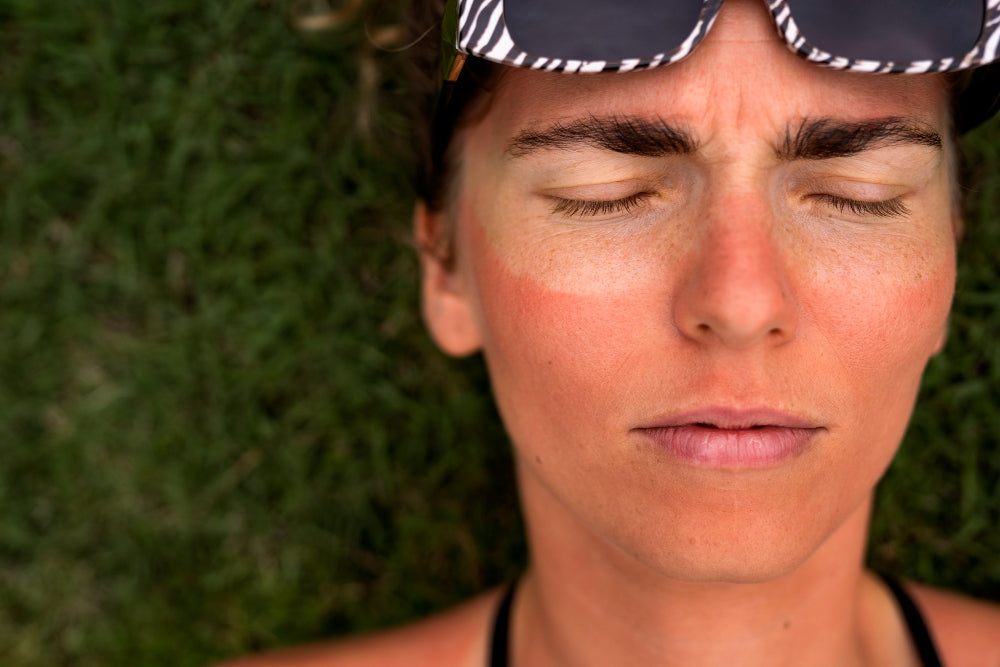Get 20% OFF Sitewide
Tags
Recent Post
Archive
- July 2024
- April 2024
- March 2024

The Ultimate Guide To Understanding, Treating & Preventing Sunburns
- By Sandiva Skincare
- 14 June, 2024
Sunburns are a common issue that many of us face during the summer season. The sweltering heat and excessive sun exposure lead to unpleasant sunburns and, over time, significant skin damage.
In this comprehensive guide, we delve into the science behind how sunburns occur, how to treat sunburns, and most importantly how to prevent them.
What is a sunburn and how does it occur?
Sunburn is a skin condition caused by overexposure to ultraviolet (UV) radiation from the sun. When the skin is exposed to excessive UV radiation, it causes damage to the DNA in skin cells, leading to inflammation and redness.
When UV rays penetrate the skin, they trigger a cascade of reactions at the cellular level. Specifically, UVB rays are primarily responsible for sunburns, penetrating the outermost layer of the skin and damaging the DNA of skin cells. This damage prompts the body's defense mechanisms, leading to inflammation, redness, and pain—the classic signs of a sunburn.
But it's not just UVB rays at play. UVA rays also contribute to sunburns, albeit indirectly, by causing oxidative stress and contributing to long-term skin damage, such as premature aging and increased risk of skin cancer.
Sunburn severity varies depending on factors such as skin type, duration of exposure, and UV intensity. Fair-skinned individuals with less melanin are more susceptible to sunburns, whereas those with darker skin tones have some built-in protection but are not immune.
Symptoms of Sunburn
Sunburn symptoms can differ in intensity depending on skin type and the duration of sun exposure. Recognising these signs early helps in taking prompt action to reduce the effects.
Typical symptoms of sunburn include:
-
Pain or Discomfort: Sunburned skin becomes painful and sensitive, especially when touched or exposed to friction from clothing.
- Redness: The sunburned area turns red and may feel warm to the touch, indicating inflammation and increased blood flow to the affected area.
-
Itching: As the skin begins to heal, itching may occur, causing discomfort and a strong urge to scratch.
-
Blistering: Sometimes, sunburn can lead to the formation of painful blisters, and may increase the risk of infection if broken.
- Peeling: During the healing process, the sunburned skin may start to peel off, which is the body's way of removing damaged cells and replacing them with new, healthy ones.
Sunburn symptoms generally appear a few hours after exposure to the sun, peaking within 24-48 hours. In more severe cases, symptoms can last several days or even weeks. Learn more about treating a sunburn below.
How to treat sunburns?
Treating sunburns promptly can help alleviate discomfort and promote healing. Here's a step-by-step guide on how to treat sunburns effectively:
Cool it down
Cool the burn with a cold compress. Make sure to use ice water, not direct ice, on the skin. Alternatively, take a cool shower or bath, avoiding hard soaps that can irritate the skin more.
Moisturise
After cooling, while the skin is still damp, apply a gentle moisturising lotion (avoid petroleum or oil-based products, as they can trap heat). Keep the skin moisturised over the next few days to manage dryness and peeling. Skin peeling is a natural process that indicates the body's effort to shed damaged cells. It’s important to allow this peeling to happen naturally.
Avoid Further Sun Exposure
Protect sunburned skin from further exposure to the sun until it has healed completely.
Replenish your Fluids
Drink plenty of fluids, including water and electrolyte-replenishing sports drinks, to stay hydrated and support skin recovery. Sunburns can draw fluids to the skin's surface, leading to dehydration.
How to Treat Sunburns Using Natural Remedies
Aloe Vera:
Aloe vera gel is renowned for its soothing and healing properties. Applying it to sunburned skin can reduce inflammation from sunburns and promote healing.
Yogurt:
Yogurt’s soothing and hydrating qualities can help alleviate inflammation and discomfort. Apply fresh yogurt to the affected area, leave it on for a few minutes, and rinse with lukewarm water.
Cucumbers:
Cucumbers also provide anti-inflammatory and cooling effects. Apply fresh cucumber slices or a blended cucumber mixture directly to the skin to soothe irritation.
Green Tea:
The antioxidants in green tea can help reduce inflammation. Soak green tea bags in cold water and apply them gently to the affected areas for relief.
How to Prevent Sunburns?
-
Use Sunscreen
Remember to apply sunscreen generously and reapply every two hours or after swimming or sweating. Sandiva’s bestselling tinted SPF Top Up powder is a lightweight powder that offers instant high protection from the sun. You can just dab it on like a compact for lightweight coverage and heavy-duty protection.
Choose a broad-spectrum sunscreen that guards against both UVA and UVB rays, with an SPF of at least 30 such as Sandiva’s One & Done Tinted Sunblock. It offers heavy-duty sun protection and is packed with the goodness of Sandalwood to calm any inflammation caused by sun exposure.
-
Wear Protective Clothing
Select long-sleeved shirts, long pants, and wide-brimmed hats to cover as much skin as possible. -
Avoid Direct Sun Exposure
Stay in the shade during peak UV radiation hours between 10 a.m. and 4 p.m. Remember that sunburn can occur even on cloudy days, as UV rays penetrate clouds. Also, be mindful that UV rays can reflect off surfaces like water, snow, and sand, intensifying exposure.
Protecting your skin from sunburns is paramount for maintaining its health and vitality. So, it is important to understand how to treat sunburns and follow precautions that can effectively prevent them. This involves mindfulness of sun exposure, consistent sunscreen use, wearing protective clothing, seeking shade, and staying hydrated. Additionally, nurturing your skin with moisturisers and soothing remedies can aid in the recovery process.
Embrace the sun responsibly, and your skin will thank you in the long run.
- Manufactured by
-
T.S.R AND COMPANY MADRAS
Old No.102 New No.2/2,
Mount Poonamallee Road, Ramapuram,
Chennai, Tamil Nadu, 600089 - Sales fulfilled by
- Tiesar Personal Care Pvt Ltd






